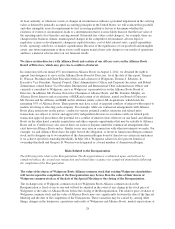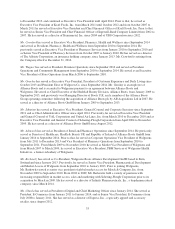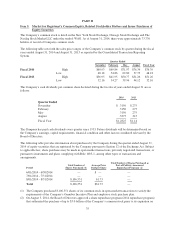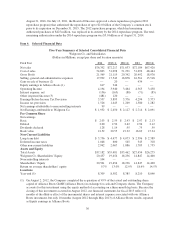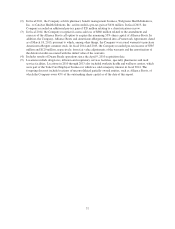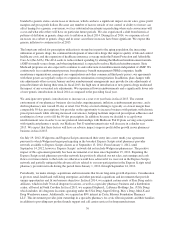Walgreens 2014 Annual Report Download - page 46
Download and view the complete annual report
Please find page 46 of the 2014 Walgreens annual report below. You can navigate through the pages in the report by either clicking on the pages listed below, or by using the keyword search tool below to find specific information within the annual report.
Item 7. Management’s Discussion and Analysis of Financial Condition and Results of Operations
The following discussion and analysis of our financial condition and results of operations should be read
together with the financial statements and the related notes included elsewhere herein. This discussion contains
forward-looking statements that involve risks and uncertainties. Our actual results may differ materially from
those discussed in forward-looking statements. Factors that might cause a difference include, but are not limited
to, those discussed under “Cautionary Note Regarding Forward-Looking Statements” below and in Item 1A
(Risk Factors) of this Form 10-K. References herein to “Walgreens,” the “Company,” “we,” “us” or “our”
refer to Walgreen Co. and its subsidiaries included in the consolidated financial statements and do not include
unconsolidated partially owned entities, such as Alliance Boots GmbH, of which we own 45% of the outstanding
share capital as of the date of this report, except as otherwise indicated or the context otherwise requires.
INTRODUCTION
Walgreens is principally a retail drugstore chain that sells prescription and non-prescription drugs and general
merchandise. General merchandise includes, among other things, convenience and fresh foods, household items,
personal care, photofinishing and beauty care. Prescription drugs represent the Company’s largest product class,
followed by general merchandise and non-prescription drugs. In fiscal 2014, fiscal 2013 and fiscal 2012,
prescription drugs represented 64%, 63% and 63% of total sales, respectively, general merchandise represented
26%, 27% and 25% of total sales, respectively, and non-prescription drugs represented 10%, 10% and 12% of
total sales, respectively. The Company offers customers the choice to have prescriptions filled at its retail
pharmacies, as well as through the mail, and customers may also place orders by phone or online including
through the Company’s mobile application.
All Company sales during the last three fiscal years occurred within the United States, Puerto Rico, U.S. Virgin
Islands and Guam. There were no export sales.
At August 31, 2014, we operated 8,309 locations in 50 states, the District of Columbia, Puerto Rico and the U.S.
Virgin Islands. Total locations do not include 437 Healthcare Clinics and 48 worksite pharmacies, which operate
primarily within other Walgreens drugstores. Total locations also do not include locations of unconsolidated
partially owned entities such as Alliance Boots.
Number of Locations
Location Type 2014 2013 2012
Drugstores 8,207 8,116 7,930
Worksite Health and Wellness Centers — 371 366
Infusion and Respiratory Services Facilities 91 82 76
Specialty Pharmacies 9 11 11
Mail Service Facilities 2 2 2
Total 8,309 8,582 8,385
The drugstore industry remains highly competitive where we compete with other drugstore chains, independent
drugstores and mail order prescription providers. We also compete with various other retailers including grocery
stores, convenience stores, mass merchants, online pharmacies, warehouse clubs and dollar stores.
Our sales, gross profit margin and gross profit dollars are impacted by, among other things, both the percentage
of prescriptions that we fill that are generic and the rate at which new generic drugs are introduced to the
market. In general, generic versions of drugs generate lower total sales dollars per prescription, but higher gross
profit margins and gross profit dollars, as compared with patent-protected brand name drugs. The positive impact
on gross profit margins and gross profit dollars typically has been significant in the first several months after a
generic version of a drug is first allowed to compete with the branded version, which is generally referred to as a
“generic conversion.” In any given year, the number of major brand name drugs that undergo a conversion from
38


